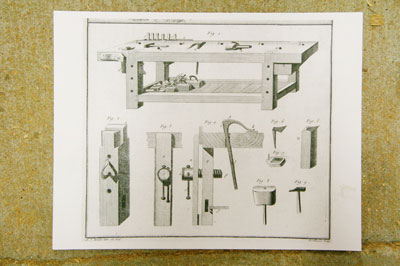
|
|
Andre Roubo's bench drawings.
|
The French Oak Roubo Workbenches
by Dick Rank
Atlanta, GA
Click on any picture to see a larger version.
Several weeks ago a remarkable event took place down in Barnesville, Georgia, about an hour's drive south from Atlanta. A group of nationally known master woodworkers, several dedicated and advanced hobbyists, and some professional woodworkers plying their trade gathered at the extensive cabinet shops of Wyatt (Bo) Childs to build sixteen woodworking benches.
But there is much more to the story.
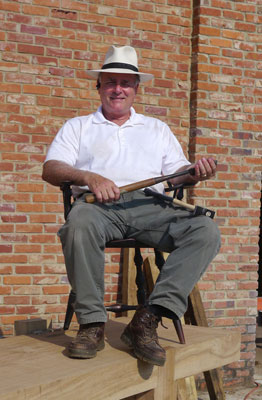 Childs is a prominent southeastern wood collector, a provider of fine custom cabinets, a manufacturer of special construction wood products, and a processor of exotic and unusual woods. While on one of his trips to Europe to obtain more choice wood, he heard of some huge old oak trees that blew down on the grounds of Versailles, France in 1990. They had been cut into large six to eight inch thick and twenty to thirty inch wide slabs twenty or more feet in length. They had been drying for a very long time. Who wouldn't want to bring them home?
Childs is a prominent southeastern wood collector, a provider of fine custom cabinets, a manufacturer of special construction wood products, and a processor of exotic and unusual woods. While on one of his trips to Europe to obtain more choice wood, he heard of some huge old oak trees that blew down on the grounds of Versailles, France in 1990. They had been cut into large six to eight inch thick and twenty to thirty inch wide slabs twenty or more feet in length. They had been drying for a very long time. Who wouldn't want to bring them home?
Fortunately, Bo had the resources to bring some of those huge hunks of white oak wood back to his shops in Barnesville, certainly no simple or easy task.
But that is typical of what dedicated lumberholics do.
Later when he, Jameel Abraham, and Ron Brese were meeting together, ideas began to flow about how to utilize some of this magnificent wood. But first there is more to tell about this very special wood.
Although historical documents don't always agree about specifics, after our nation was founded, President Washington sent a gift of tulip poplars to Marie Antoinette as a token of the strong relationship between the United States and France. He was a horticulturist, lover of the earth and his natural surroundings, and he wanted to share our unique bounty of plants and trees with his friends in Europe. Along with Lafayette, Washington felt that the tulip poplar was especially American, and so tulip poplar saplings accompanied Lafayette back to France and to Versailles. Marie Antoinette had them planted there.
At about the same time, as Washington's Secretary of State, Thomas Jefferson made lengthy visits to France as he carried out his cabinet responsibilities. He, too, was a renaissance man who was a gifted designer, horticulturist, architect, farmer and above all, a statesman. One of the friends he made while in France was a Countess living on Versaille property gifted to her by the King. Upon returning to our country, Jefferson received special flower seeds from her. He subsequently returned the favor with the best acorns from the very best of white oak trees at Monticello. They, too, were planted at Versailles. So now some of that resulting wood is resting in Barnesville, Georgia, and part of it has become sixteen special woodworking benches.
I had to see this weeklong Jefferson/French Oak adventure for myself.
Bo Childs and Jameel Abraham agreed to let me circulate among the toiling woodworkers and take pictures as they created their own benches from this wood. The temperature was well above ninety, so all workers truly invested lots of sweat equity in their benches.
Approaching Barnesville, I wasn't sure if I would recognize Bo Childs' enterprise, but a minute later I saw a thirty foot high pile of sawdust to the right. I knew then that I had arrived. I turned into the driveway, and ahead of me were two long shops, lumber storage buildings and acres of piled lumber drying. This was it.
Walking into the first shop doors, I was immediately surrounded by many special workers bent over their large oak timbers. The sounds were from many chisels being hit with mallets and the 'ssnnik' of extremely sharp #5 planes cutting wide shavings so thin that you could see through them. A rough sawn oak bench top required lots of planing and scraping to smooth all sides of such magnificent wood into very flat surfaces. Only occasionally a power tool could be heard. Hand tools were being used as much as possible, and they all were very, very sharp. It should be mentioned that Bo's crew had already run the rough timbers through a huge planer that planed both sides at the same time.
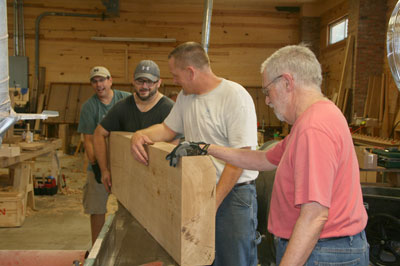
|
|
Turning the monster benchtop.
|
Directly in front of me, an especially long bench top weighing several hundred pounds was being turned by four strong men so that the opposite long edge could also be smoothed. That extra long bench was destined to remain in Bo's shop and put to good use.
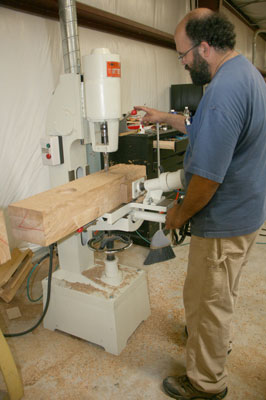 On this second day of the event, it appeared that all participants were keeping pace with each other. Most bench tops were almost ready, and some rabbets were being cut to receive the legs. The large and deep mortises on the legs were also previously cut by Jameel on a very large power mortiser with hydraulically operated holding clamps and vertical spindle travel. Without that machine, the participants would have taken another week to complete the benches.
On this second day of the event, it appeared that all participants were keeping pace with each other. Most bench tops were almost ready, and some rabbets were being cut to receive the legs. The large and deep mortises on the legs were also previously cut by Jameel on a very large power mortiser with hydraulically operated holding clamps and vertical spindle travel. Without that machine, the participants would have taken another week to complete the benches.
At first glance, the Roubo bench appears overbuilt, but its design was very carefully thought out by Andre Roubo, the outstanding French artisan who fortunately wrote down his techniques and designs in the late 1700s for us to copy. Roubo's bench has been featured in recent woodworking magazines and the writings of Chris Schwarz, one of the master craftsman participants.
Plans for a similar bench are available from Highland Woodworking.
If you have spent much time hand planing the face of a big board held down on the bench top, you will know that benches must be heavy, and they must not rack or wiggle when a plane is properly pushed along the board face. Roubo made every bench part extra thick to provide enough weight, and the leg joints are dovetailed all the way up through the top. These benches will stay put.
Most of the old benches of that period use carefully selected wood to make the vise parts. You can see the beautifully cut spiral threads on the huge wooden screw that firmly clamps the work piece. All the screws were made by Lake Erie Tool Works. To complete the picture of the perfect bench, hand forged iron hold downs, vise handles, ring ferrules and bench stops were made ahead of time by Peter Ross.
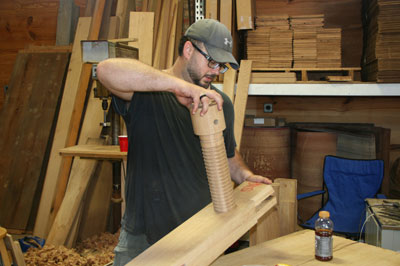
|
|
Justin Leib is pleased with his bench screw.
|
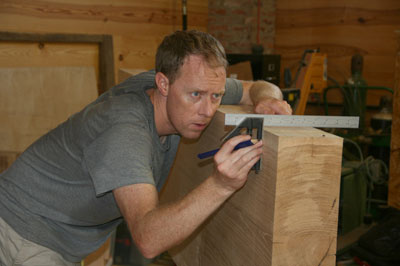
|
|
Brad Daubenmire keeping edges square.
|
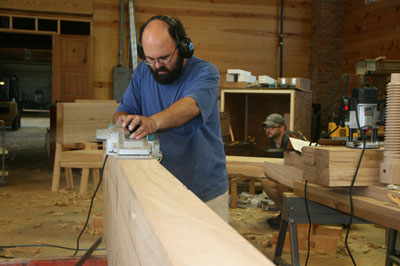
|
|
Jameel Abraham smoothing the really big benchtop.
|
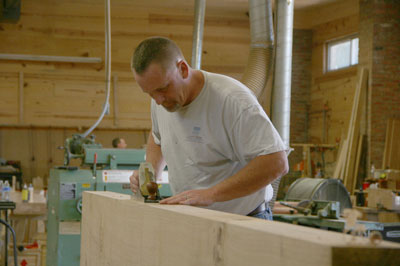
|
|
Will Myers planing his benchtop the hard way.
|
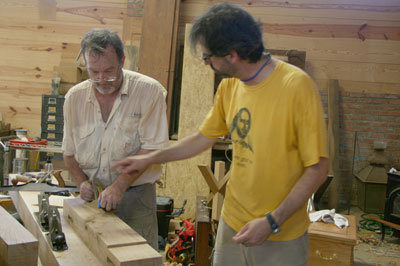
|
|
Chris Schwarz helping Allan Alexander to plane squirrely wood grain.
|
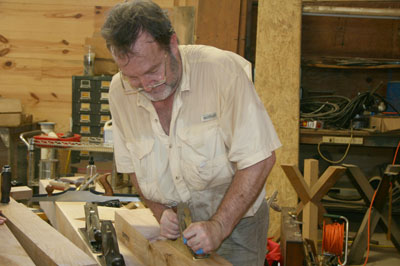
|
|
Allan Alexander trying out Chris's suggestions.
|
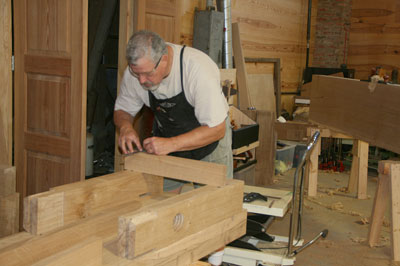
|
|
Steve Quehl drawing perfect lines.
|
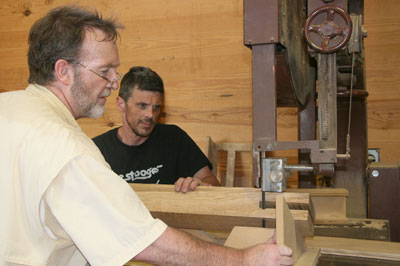
|
|
Raney Nelson cutting Allan's leg dovetails.
|
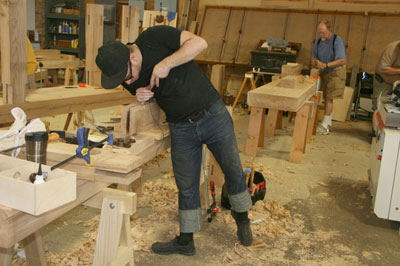
|
|
Niels Cosman cutting leg dovetails.
|
As the afternoon progressed, some significant sharing was evident.
Occasionally, one of the Hobbyists would ask for help in getting a particular task done well. Chris Schwarz gladly moved around the shop, providing suggestions from time to time, and everyone teamed up with others when needed. What a privilege it was to have this opportunity.
By the end of the second day, legs were complete and some legs were temporarily inserted into the tops. With the expertise level in the shop, the fit of the legs in the tops was so incredibly close that disassembly usually required many mallet hits.
As I circulated around the shop, I asked every participant where his bench would reside, and every participant firmly said, "In my shop." With the wood's history and quality, it would be such a pleasure to step up to that bench daily and make beautiful things. And, with a long period of use during which the bench acquires countless small cuts, scratches and bruises, each bench will become even more proof of good hands, good tools, and a commitment to excellence.
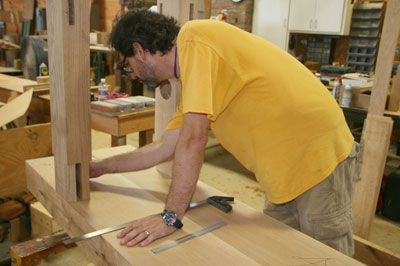
|
|
Chris Schwarz marking out dovetails and mortises.
|
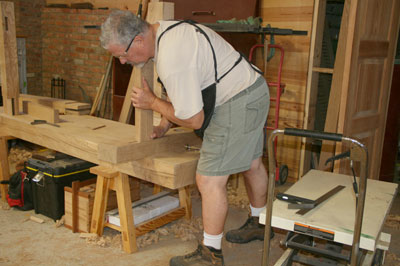
|
|
Steve Quehl fitting legs.
|
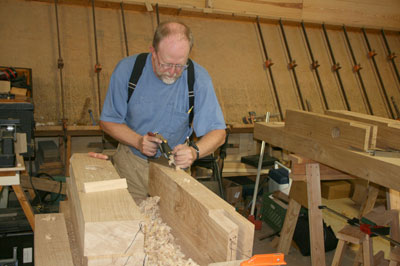
|
|
John Pratt making perfect shavings.
|
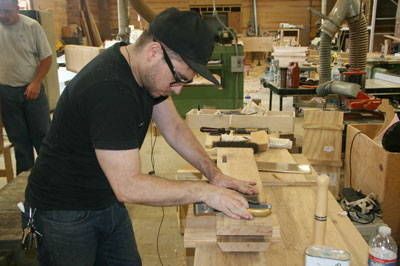
|
|
Niels Cosman demonstrating his plane set-up.
|
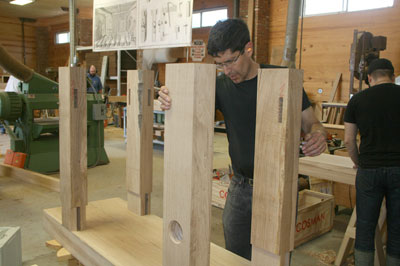
|
|
Jeff Miller positioning his legs.
|
With a little extra time still available, I took a tour around the "campus." Two cavernous buildings held endless stacks of premier wood. Alongside them is a long row of electric lumber drying kilns. And behind the buildings are several acres of lumber stacked for air drying, still the best way to get a near perfect board.
Bo finished off my almost perfect day by handing me a couple of yard-long pieces of the Jefferson white oak. I think that Jefferson would heartily approve of how some of his Versailles white oak was put to good use at Bo Childs' recent event.
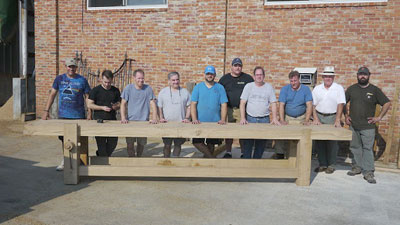
|
|
Bo Childs' 16 foot finished Roubo workbench.
|
To find out more and purchase your own
Roubo Workbench Plans and Hardware
, visit the
Highland Woodworking Website
.